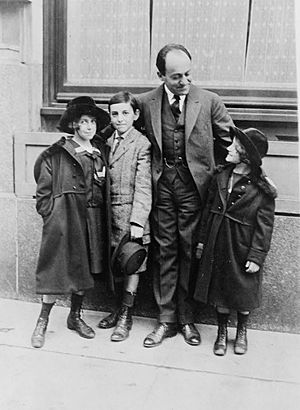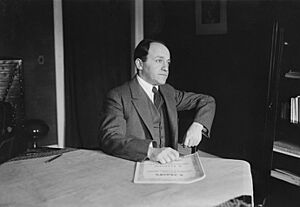Ernest Bloch facts for kids
Ernest Bloch (born July 24, 1880 – died July 15, 1959) was a famous composer from Switzerland who later became an American citizen. He was a very important artist in his time and is remembered as one of the greatest Swiss composers ever. Besides writing music, Bloch also taught at universities. He became a special professor, called a Professor Emeritus, at the University of California, Berkeley in 1952.
Biography
Ernest Bloch was born in Geneva, Switzerland, on July 24, 1880. His parents were Jewish. He started playing the violin when he was 9 years old and began writing his own music soon after.
He studied music in Brussels, where one of his teachers was the famous violinist Eugène Ysaÿe. Bloch then traveled around Europe. He studied in Germany and Paris before returning to Geneva. In 1916, he moved to the United States and became a US citizen in 1924.
In the US, Bloch taught music at several schools. Some of his students became famous composers themselves, like George Antheil and Roger Sessions.
In 1917, Bloch became the first composition teacher at the Mannes School of Music. He taught there for three years. In 1920, he became the first Musical Director of the Cleveland Institute of Music.
In 1925, Bloch moved to San Francisco. He became the director of the San Francisco Conservatory of Music and stayed in that job until 1930. After that, he went back to Switzerland for a while. He wrote a special piece of music called "Avodath Hakodesh" ("Sacred Service") there. He returned to the US in 1939.
Bloch started teaching music at the University of California, Berkeley, in 1941. He taught there one semester each year until he retired in 1952. He and his wife lived mostly in a small town called Agate Beach, Oregon. In 1947, he helped start a summer music school called the Music Academy of the West.
In 1952, he was given the special title of Professor Emeritus at the University of California. He wrote a piece called "In Memoriam" that year after a friend passed away.
Ernest Bloch died on July 15, 1959, in Portland, Oregon, from cancer. He was 78 years old. His daughter, Lucienne Bloch, and her husband made several death masks of him. This was a special tradition to create a memory or portrait of someone who had passed away. His body was cremated, and his ashes were scattered in the Pacific Ocean near his home.
Music
Many people say that Bloch's music shows his Jewish background. However, his music also had many other inspirations. He was very good at using different sounds and colors in his music to create certain feelings. For example, some of his works sound like the Old Testament, while others might make you think of the South Seas or China. He wrote pieces like Helvetia (about Switzerland) and America (about the US), alongside works inspired by Jewish life.
Bloch's musical style is unique and doesn't fit into just one category. He studied with different teachers and even talked with famous composers like Gustav Mahler and Claude Debussy. Many of his pieces have Hebrew-inspired titles, showing his strong connection to his Jewish heritage. His father had once wanted to be a rabbi, and Ernest grew up with strong religious beliefs. He felt that writing music that showed his Jewish identity was the best way to create powerful and meaningful music.
Bloch used many modern musical techniques in his compositions. He used different musical scales and harmonies. For example, he used special chords that sound like many notes played at once, and he also used patterns of notes in unique ways.
Family

Ernest Bloch and his wife, Marguerite Schneider (1881–1963), had three children: Ivan, Suzanne, and Lucienne.
- Ivan, born in 1905, became an engineer.
- Suzanne Bloch, born in 1907, was a musician. She loved Renaissance music and taught instruments like the harpsichord and lute at the Juilliard School in New York.
- Lucienne Bloch, born in 1909, was a photographer. She worked with the famous artist Diego Rivera on a mural project. She also became friends with Rivera's wife, the artist Frida Kahlo, and took important photos of Kahlo. She even took the only photos of Rivera's mural before it was destroyed.
Photography
Ernest Bloch was also interested in photography. The Western Jewish History Center in Berkeley, California, has a small collection of his photographs.
Bloch's photography was discovered in 1970. With help from his children, many of his photos were developed and printed.
More than 6,000 negatives and 2,000 prints of Bloch's photographs are kept at the Ernest Bloch Archive at the Center for Creative Photography at the University of Arizona in Tucson. This archive also holds photos by other famous photographers like Ansel Adams.
Some of the pictures Bloch took in his home in Switzerland can be seen online. These photos were given to a special archive in Switzerland.
Legacy
Quick facts for kids |
|
|
Ernest Bloch House
|
|
| Lua error in Module:Location_map at line 420: attempt to index field 'wikibase' (a nil value). | |
| Nearest city | Agate Beach, Oregon |
|---|---|
| NRHP reference No. | 09000049 |
| Added to NRHP | February 9, 2009 |
Ernest Bloch's home in Agate Beach was added to the National Register of Historic Places in 2009. This means it's a special historical site.
A memorial for Ernest Bloch was first placed near his house in 1976. Later, it was moved to a more public spot in front of the Newport Performing Arts Center in Newport, Oregon. In 2009, a street intersection in Newport was named Ernest Bloch Place. In 2016, a special roadside area near Agate Beach was officially named the Ernest Bloch Memorial Wayside. New monuments were added there in 2018.
A group called the Ernest Bloch Legacy Project was started in 2003 to help keep his memory alive. See: List of music students by teacher: A to B#Ernest Bloch.
See also
 In Spanish: Ernest Bloch para niños
In Spanish: Ernest Bloch para niños


